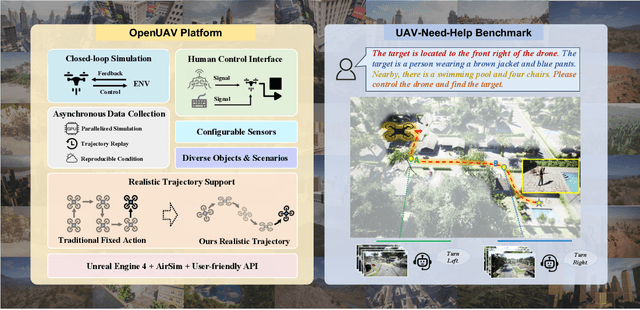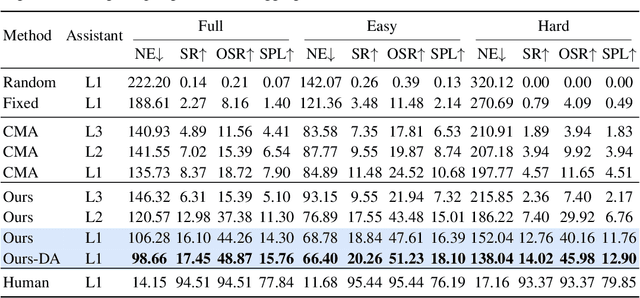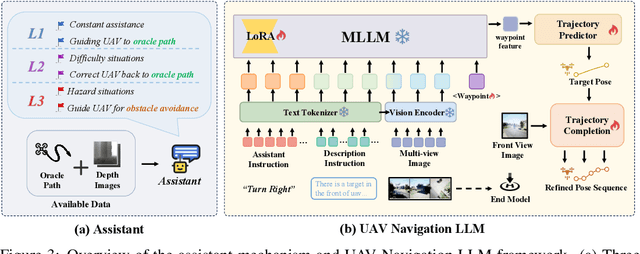Jinyu Chen
STARC: See-Through-Wall Augmented Reality Framework for Human-Robot Collaboration in Emergency Response
Sep 19, 2025Abstract:In emergency response missions, first responders must navigate cluttered indoor environments where occlusions block direct line-of-sight, concealing both life-threatening hazards and victims in need of rescue. We present STARC, a see-through AR framework for human-robot collaboration that fuses mobile-robot mapping with responder-mounted LiDAR sensing. A ground robot running LiDAR-inertial odometry performs large-area exploration and 3D human detection, while helmet- or handheld-mounted LiDAR on the responder is registered to the robot's global map via relative pose estimation. This cross-LiDAR alignment enables consistent first-person projection of detected humans and their point clouds - rendered in AR with low latency - into the responder's view. By providing real-time visualization of hidden occupants and hazards, STARC enhances situational awareness and reduces operator risk. Experiments in simulation, lab setups, and tactical field trials confirm robust pose alignment, reliable detections, and stable overlays, underscoring the potential of our system for fire-fighting, disaster relief, and other safety-critical operations. Code and design will be open-sourced upon acceptance.
Energy-Constrained Navigation for Planetary Rovers under Hybrid RTG-Solar Power
Sep 18, 2025Abstract:Future planetary exploration rovers must operate for extended durations on hybrid power inputs that combine steady radioisotope thermoelectric generator (RTG) output with variable solar photovoltaic (PV) availability. While energy-aware planning has been studied for aerial and underwater robots under battery limits, few works for ground rovers explicitly model power flow or enforce instantaneous power constraints. Classical terrain-aware planners emphasize slope or traversability, and trajectory optimization methods typically focus on geometric smoothness and dynamic feasibility, neglecting energy feasibility. We present an energy-constrained trajectory planning framework that explicitly integrates physics-based models of translational, rotational, and resistive power with baseline subsystem loads, under hybrid RTG-solar input. By incorporating both cumulative energy budgets and instantaneous power constraints into SE(2)-based polynomial trajectory optimization, the method ensures trajectories that are simultaneously smooth, dynamically feasible, and power-compliant. Simulation results on lunar-like terrain show that our planner generates trajectories with peak power within 0.55 percent of the prescribed limit, while existing methods exceed limits by over 17 percent. This demonstrates a principled and practical approach to energy-aware autonomy for long-duration planetary missions.
DVDP: An End-to-End Policy for Mobile Robot Visual Docking with RGB-D Perception
Sep 16, 2025Abstract:Automatic docking has long been a significant challenge in the field of mobile robotics. Compared to other automatic docking methods, visual docking methods offer higher precision and lower deployment costs, making them an efficient and promising choice for this task. However, visual docking methods impose strict requirements on the robot's initial position at the start of the docking process. To overcome the limitations of current vision-based methods, we propose an innovative end-to-end visual docking method named DVDP(direct visual docking policy). This approach requires only a binocular RGB-D camera installed on the mobile robot to directly output the robot's docking path, achieving end-to-end automatic docking. Furthermore, we have collected a large-scale dataset of mobile robot visual automatic docking dataset through a combination of virtual and real environments using the Unity 3D platform and actual mobile robot setups. We developed a series of evaluation metrics to quantify the performance of the end-to-end visual docking method. Extensive experiments, including benchmarks against leading perception backbones adapted into our framework, demonstrate that our method achieves superior performance. Finally, real-world deployment on the SCOUT Mini confirmed DVDP's efficacy, with our model generating smooth, feasible docking trajectories that meet physical constraints and reach the target pose.
AeroDuo: Aerial Duo for UAV-based Vision and Language Navigation
Aug 21, 2025Abstract:Aerial Vision-and-Language Navigation (VLN) is an emerging task that enables Unmanned Aerial Vehicles (UAVs) to navigate outdoor environments using natural language instructions and visual cues. However, due to the extended trajectories and complex maneuverability of UAVs, achieving reliable UAV-VLN performance is challenging and often requires human intervention or overly detailed instructions. To harness the advantages of UAVs' high mobility, which could provide multi-grained perspectives, while maintaining a manageable motion space for learning, we introduce a novel task called Dual-Altitude UAV Collaborative VLN (DuAl-VLN). In this task, two UAVs operate at distinct altitudes: a high-altitude UAV responsible for broad environmental reasoning, and a low-altitude UAV tasked with precise navigation. To support the training and evaluation of the DuAl-VLN, we construct the HaL-13k, a dataset comprising 13,838 collaborative high-low UAV demonstration trajectories, each paired with target-oriented language instructions. This dataset includes both unseen maps and an unseen object validation set to systematically evaluate the model's generalization capabilities across novel environments and unfamiliar targets. To consolidate their complementary strengths, we propose a dual-UAV collaborative VLN framework, AeroDuo, where the high-altitude UAV integrates a multimodal large language model (Pilot-LLM) for target reasoning, while the low-altitude UAV employs a lightweight multi-stage policy for navigation and target grounding. The two UAVs work collaboratively and only exchange minimal coordinate information to ensure efficiency.
CoST: Efficient Collaborative Perception From Unified Spatiotemporal Perspective
Aug 01, 2025Abstract:Collaborative perception shares information among different agents and helps solving problems that individual agents may face, e.g., occlusions and small sensing range. Prior methods usually separate the multi-agent fusion and multi-time fusion into two consecutive steps. In contrast, this paper proposes an efficient collaborative perception that aggregates the observations from different agents (space) and different times into a unified spatio-temporal space simultanesouly. The unified spatio-temporal space brings two benefits, i.e., efficient feature transmission and superior feature fusion. 1) Efficient feature transmission: each static object yields a single observation in the spatial temporal space, and thus only requires transmission only once (whereas prior methods re-transmit all the object features multiple times). 2) superior feature fusion: merging the multi-agent and multi-time fusion into a unified spatial-temporal aggregation enables a more holistic perspective, thereby enhancing perception performance in challenging scenarios. Consequently, our Collaborative perception with Spatio-temporal Transformer (CoST) gains improvement in both efficiency and accuracy. Notably, CoST is not tied to any specific method and is compatible with a majority of previous methods, enhancing their accuracy while reducing the transmission bandwidth.
LLaVA-ST: A Multimodal Large Language Model for Fine-Grained Spatial-Temporal Understanding
Jan 14, 2025Abstract:Recent advancements in multimodal large language models (MLLMs) have shown promising results, yet existing approaches struggle to effectively handle both temporal and spatial localization simultaneously. This challenge stems from two key issues: first, incorporating spatial-temporal localization introduces a vast number of coordinate combinations, complicating the alignment of linguistic and visual coordinate representations; second, encoding fine-grained temporal and spatial information during video feature compression is inherently difficult. To address these issues, we propose LLaVA-ST, a MLLM for fine-grained spatial-temporal multimodal understanding. In LLaVA-ST, we propose Language-Aligned Positional Embedding, which embeds the textual coordinate special token into the visual space, simplifying the alignment of fine-grained spatial-temporal correspondences. Additionally, we design the Spatial-Temporal Packer, which decouples the feature compression of temporal and spatial resolutions into two distinct point-to-region attention processing streams. Furthermore, we propose ST-Align dataset with 4.3M training samples for fine-grained spatial-temporal multimodal understanding. With ST-align, we present a progressive training pipeline that aligns the visual and textual feature through sequential coarse-to-fine stages.Additionally, we introduce an ST-Align benchmark to evaluate spatial-temporal interleaved fine-grained understanding tasks, which include Spatial-Temporal Video Grounding (STVG) , Event Localization and Captioning (ELC) and Spatial Video Grounding (SVG). LLaVA-ST achieves outstanding performance on 11 benchmarks requiring fine-grained temporal, spatial, or spatial-temporal interleaving multimodal understanding. Our code, data and benchmark will be released at Our code, data and benchmark will be released at https://github.com/appletea233/LLaVA-ST .
Deploying Foundation Model Powered Agent Services: A Survey
Dec 18, 2024



Abstract:Foundation model (FM) powered agent services are regarded as a promising solution to develop intelligent and personalized applications for advancing toward Artificial General Intelligence (AGI). To achieve high reliability and scalability in deploying these agent services, it is essential to collaboratively optimize computational and communication resources, thereby ensuring effective resource allocation and seamless service delivery. In pursuit of this vision, this paper proposes a unified framework aimed at providing a comprehensive survey on deploying FM-based agent services across heterogeneous devices, with the emphasis on the integration of model and resource optimization to establish a robust infrastructure for these services. Particularly, this paper begins with exploring various low-level optimization strategies during inference and studies approaches that enhance system scalability, such as parallelism techniques and resource scaling methods. The paper then discusses several prominent FMs and investigates research efforts focused on inference acceleration, including techniques such as model compression and token reduction. Moreover, the paper also investigates critical components for constructing agent services and highlights notable intelligent applications. Finally, the paper presents potential research directions for developing real-time agent services with high Quality of Service (QoS).
Towards Realistic UAV Vision-Language Navigation: Platform, Benchmark, and Methodology
Oct 10, 2024



Abstract:Developing agents capable of navigating to a target location based on language instructions and visual information, known as vision-language navigation (VLN), has attracted widespread interest. Most research has focused on ground-based agents, while UAV-based VLN remains relatively underexplored. Recent efforts in UAV vision-language navigation predominantly adopt ground-based VLN settings, relying on predefined discrete action spaces and neglecting the inherent disparities in agent movement dynamics and the complexity of navigation tasks between ground and aerial environments. To address these disparities and challenges, we propose solutions from three perspectives: platform, benchmark, and methodology. To enable realistic UAV trajectory simulation in VLN tasks, we propose the OpenUAV platform, which features diverse environments, realistic flight control, and extensive algorithmic support. We further construct a target-oriented VLN dataset consisting of approximately 12k trajectories on this platform, serving as the first dataset specifically designed for realistic UAV VLN tasks. To tackle the challenges posed by complex aerial environments, we propose an assistant-guided UAV object search benchmark called UAV-Need-Help, which provides varying levels of guidance information to help UAVs better accomplish realistic VLN tasks. We also propose a UAV navigation LLM that, given multi-view images, task descriptions, and assistant instructions, leverages the multimodal understanding capabilities of the MLLM to jointly process visual and textual information, and performs hierarchical trajectory generation. The evaluation results of our method significantly outperform the baseline models, while there remains a considerable gap between our results and those achieved by human operators, underscoring the challenge presented by the UAV-Need-Help task.
Controllable Navigation Instruction Generation with Chain of Thought Prompting
Jul 10, 2024Abstract:Instruction generation is a vital and multidisciplinary research area with broad applications. Existing instruction generation models are limited to generating instructions in a single style from a particular dataset, and the style and content of generated instructions cannot be controlled. Moreover, most existing instruction generation methods also disregard the spatial modeling of the navigation environment. Leveraging the capabilities of Large Language Models (LLMs), we propose C-Instructor, which utilizes the chain-of-thought-style prompt for style-controllable and content-controllable instruction generation. Firstly, we propose a Chain of Thought with Landmarks (CoTL) mechanism, which guides the LLM to identify key landmarks and then generate complete instructions. CoTL renders generated instructions more accessible to follow and offers greater controllability over the manipulation of landmark objects. Furthermore, we present a Spatial Topology Modeling Task to facilitate the understanding of the spatial structure of the environment. Finally, we introduce a Style-Mixed Training policy, harnessing the prior knowledge of LLMs to enable style control for instruction generation based on different prompts within a single model instance. Extensive experiments demonstrate that instructions generated by C-Instructor outperform those generated by previous methods in text metrics, navigation guidance evaluation, and user studies.
Omnidirectional Information Gathering for Knowledge Transfer-based Audio-Visual Navigation
Aug 20, 2023Abstract:Audio-visual navigation is an audio-targeted wayfinding task where a robot agent is entailed to travel a never-before-seen 3D environment towards the sounding source. In this article, we present ORAN, an omnidirectional audio-visual navigator based on cross-task navigation skill transfer. In particular, ORAN sharpens its two basic abilities for a such challenging task, namely wayfinding and audio-visual information gathering. First, ORAN is trained with a confidence-aware cross-task policy distillation (CCPD) strategy. CCPD transfers the fundamental, point-to-point wayfinding skill that is well trained on the large-scale PointGoal task to ORAN, so as to help ORAN to better master audio-visual navigation with far fewer training samples. To improve the efficiency of knowledge transfer and address the domain gap, CCPD is made to be adaptive to the decision confidence of the teacher policy. Second, ORAN is equipped with an omnidirectional information gathering (OIG) mechanism, i.e., gleaning visual-acoustic observations from different directions before decision-making. As a result, ORAN yields more robust navigation behaviour. Taking CCPD and OIG together, ORAN significantly outperforms previous competitors. After the model ensemble, we got 1st in Soundspaces Challenge 2022, improving SPL and SR by 53% and 35% relatively.
 Add to Chrome
Add to Chrome Add to Firefox
Add to Firefox Add to Edge
Add to Edge